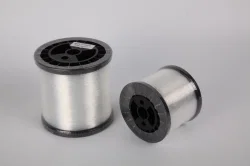Here are some common types of fishing lines
2023-12-18
Fishing lines are critical components of fishing tackle, connecting the angler to the fish. They come in various materials, diameters, and strengths, each suited to specific fishing applications and conditions. Here are some common types of fishing lines:
1. Monofilament Fishing Line:
- Material: Single-strand nylon.
- Features:
- Stretchable, which can be an advantage for absorbing shocks and reducing the chance of breaking.
- Buoyant, suitable for topwater fishing.
- Applications: Versatile; used in freshwater and saltwater for various fishing styles.
2. Braided Fishing Line:
- Material: Multiple strands of synthetic fibers like Spectra or Dyneema.
- Features:
- High strength-to-diameter ratio.
- Minimal stretch, providing better sensitivity and hook-setting power.
- Thin and strong, allowing for increased line capacity on reels.
- Applications: Suitable for heavy cover, deepwater fishing, and scenarios where sensitivity is crucial.
3. Fluorocarbon Fishing Line:
- Material: Fluoropolymer compounds.
- Features:
- Nearly invisible underwater due to its refractive index.
- Low stretch, offering enhanced sensitivity.
- Abrasion-resistant, suitable for fishing in and around structures.
- Applications: Often used as a leader material, especially in clear water and finesse fishing.
4. Fly Fishing Line:
- Material: Specialized lines for fly fishing, usually made of PVC or other coatings.
- Features:
- Weighted to help cast lightweight flies.
- Floating, sinking, or intermediate sink rates available.
- Applications: Essential for fly fishing; the type of line depends on the fishing conditions.
5. Lead Core Fishing Line:
- Material: Braided line with a lead core.
- Features:
- Dense and sinks in water.
- Color-coded to indicate depth.
- Applications: Trolling in deep water to reach specific depths.
6. Ice Fishing Line:
- Material: Typically monofilament or fluorocarbon.
- Features:
- Low memory to prevent coiling in cold conditions.
- Sensitive for detecting light bites.
- Applications: Specifically designed for ice fishing; may be used in conjunction with ice fishing reels.
7. Nylon Coated Wire Line:
- Material: Braided wire coated with nylon.
- Features:
- Strong and durable.
- Often used in saltwater trolling applications.
- Applications: Suitable for trolling in saltwater for species like musky and pike.
8. Tape Line:
- Material: Fabric or plastic tapes.
- Features:
- Used in traditional Japanese tenkara fishing.
- Lightweight and easy to handle.
- Applications: Specifically designed for tenkara fly fishing.
When choosing a fishing line, consider factors such as the target species, fishing technique, water conditions, and personal preferences. It's important to match the line with the rod and reel specifications and to check the line regularly for signs of wear or damage. Regularly replacing fishing line helps maintain its integrity and ensures a higher likelihood of success on the water.



